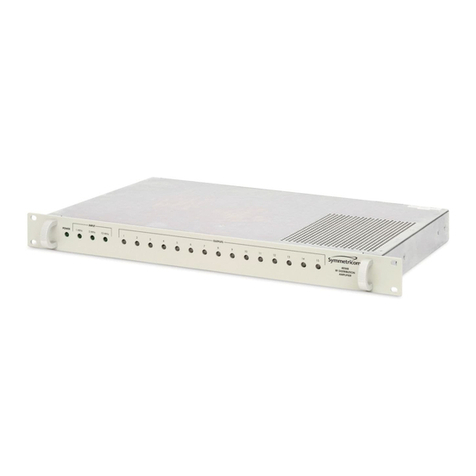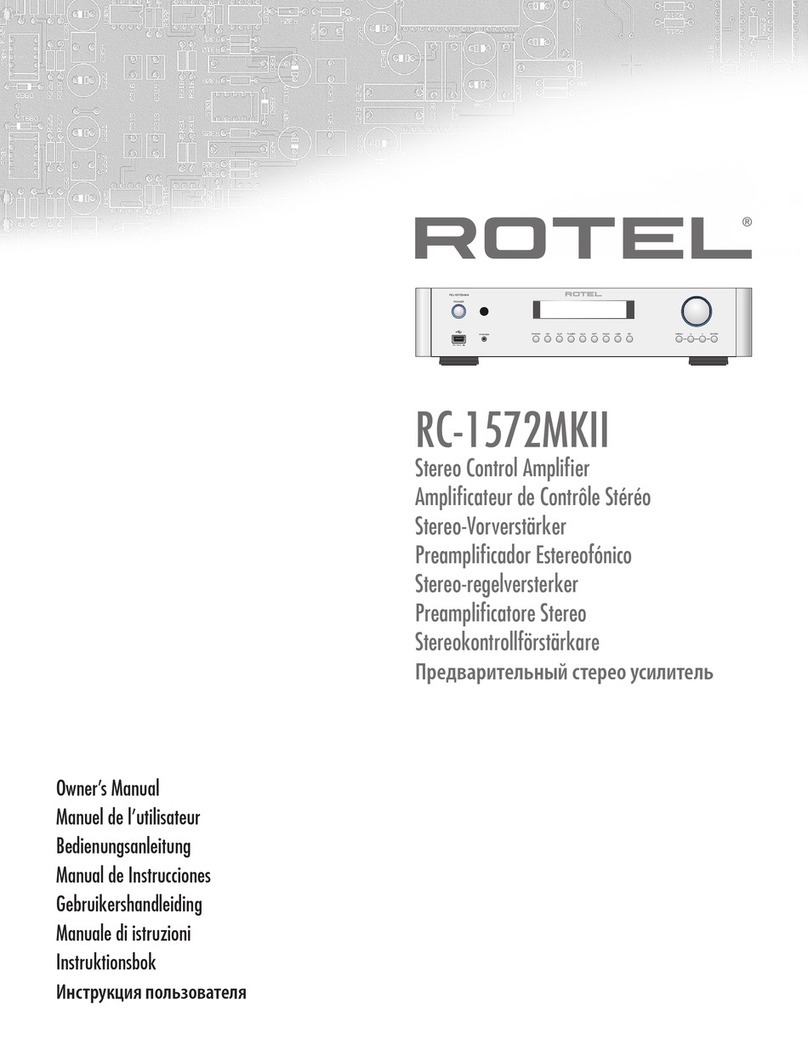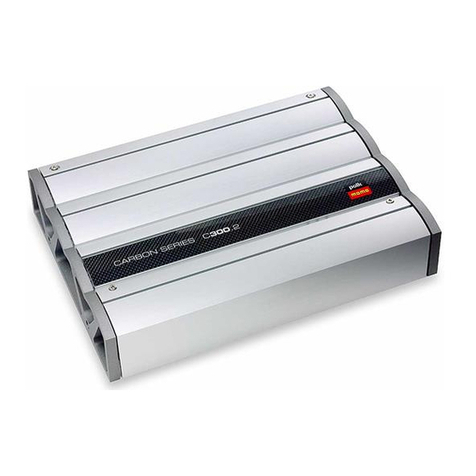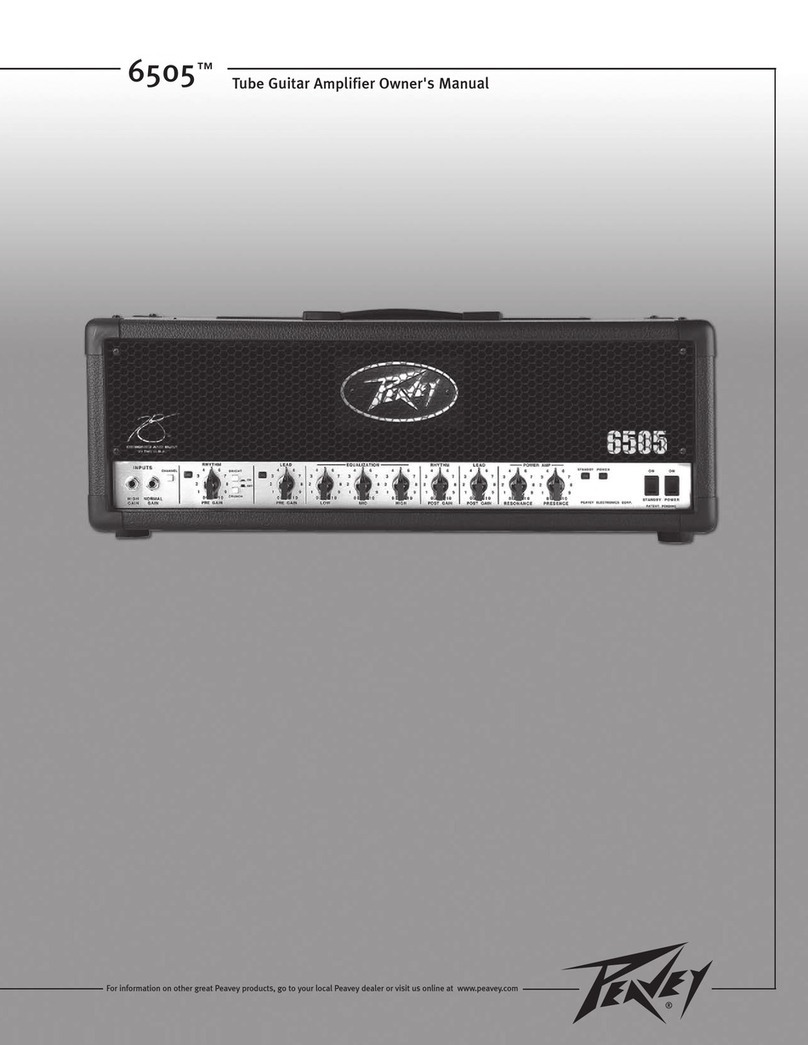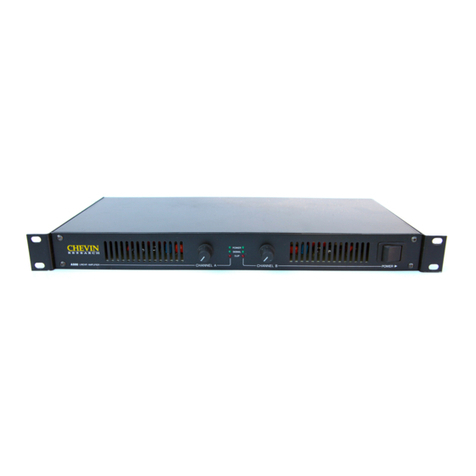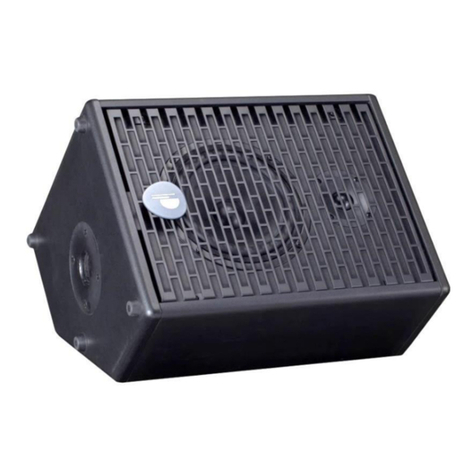Milmega Ametek AS Series User manual

AS SERIES POWER AMPLIFIER
Operation Manual
Manual number H012649
Revision: 1
First edition published 26
th
April 2018
Any disclosure to third parties, or reproduction by any
means of any part of this manual without the written
consent of Milmega, is prohibited.

AS Series Manual: H012649 Rev: 1
2
For Sales
China
AMETEK Commercial Enterprise
(Shanghai) Co. Ltd.
Beijing Branch
Western Section, 2nd Floor
Jing Dong Fang Building (B10)
Chaoyang District
Beijing, China, 100015
T +86 10 8526 2111
chinasales@teseq.com
Japan
AMETEK Co. Ltd.
Tokyo office
3rd floor, Shiba NBF Tower,
1-1-30 Shiba-Daimon, Minato-ku
Tokyo, 105-0012, Japan
T +81 3 6809 2401
cts-japan.sales@ametek.com
Shanghai Office:
Part A1, A4, 2nd floor, Building No. 1
No. 526 Fute 3rd Road East
Pilot Free Trade Zone, Shanghai 200131,
China
T +86 21 5868 5111
Nagoya Office
1-329 Kifune Meito-ku Nagoya-shi
Aichi-ken, 465-0058, Japan
T +81 52 709 5501
Guangzhou Office:
Room 1410-12, Yian Plaza
33 Jian She Liu Ma Road
Guangzhou, China
T +86 20 8363 4768
Poland
AMETEK CTS Germany GmbH
Biuro w Polsce
ul. Ogrodowa 31/35
00-893 Warszawa, Polen
T +48 518 643 512
infopolska.cts@ametek.com
Germany
AMETEK CTS Germany GmbH
Lünener Straße 211
59174 Kamen, Deutschland
T +49 2307 26070-0
sales.cts.de@ametek.com
service.rf.cts@ametek.com
Singapore
AMETEK Singapore Pte. Ltd.
No. 43 Changi South Avenue 2
#04-01 Singapore 486164
T +65 6484 2388
singaporesales.cts@ametek.com
Great Britain
AMETEK CTS (UK)
Milmega
Park Road
Ryde
Isle of Wight PO33 2BE
Great Britain
T +44 1983 618004
milmega.sales@ametek.com
Taiwan
AMETEK Taiwan Corp. Ltd.
10F-5, No. 120, Sec 2,
GongDaoWu Rd.,
Hsinchu City 30072, Taiwan
T +886 3 57 5099
taiwan.sales.cts@ametek.com
USA
Teseq Inc. / AMETEK CTS
52 Mayfield Avenue
Edison, New Jersey 08837, USA
T +1 732 417 0501
Toll free: +1 888 417 0501
usasales.cts@ametek.com
usasupport.cts@ametek.com

AS Series Manual: H012649 Rev: 1
3
Table of Contents
1.
INTRODUCTION 5
1.1
About this manual 5
1.2
Amplifier description 5
2.
SAFETY 6
2.1
General 6
2.2
Safety symbols and terms 6
2.3
Safety precautions 7
3.
INSTALLATION 9
3.1
General 9
3.2
Connecting the line cord 10
3.3
Connecting the chassis ground cable 10
3.4
Connecting the RF cables 10
3.5
Connecting the Safety interlock 10
4.
PROTECTION CIRCUITS 11
4.1
Over Heat Protection 11
4.2
Input Protection 11
4.3
Power Supply Faults 11
4.4
Mismatch Protection 11
5.
AMPLIFIER OPERATION 12
5.1
Safety interlock Operation 12
5.2
Switching on line supply 12
5.3
Cooling Fan Operation 13
5.4
General 13
5.5
Standby / RF On 13
5.6
Reset 14
5.7
Local 14
5.8
Gain Control 14
5.9
GPIB 15
6.
INDICATORS & FUNCTIONS 15
6.1
General 15
6.2
Touch Screen Indication 15
7.
CONNECTIONS 16
7.1
General 16
7.2
RF input, N Type connector 16
7.3
RF output N-Type or 7/16 (Model Dependent) 17
7.4
Sample Ports, N-TYPE Female 17
7.5
Line supply input connector 18
7.6
Safety interlock 18
7.7
IEEE-488 Convector 19
7.8
Ethernet 19
7.9
RS232 Connection 19
7.10
USB Connection 20
7.11
Ground post (8-32 thread) 20

AS Series Manual: H012649 Rev: 1
4
8.
REMOTE CONTROL CONNECTIONS & OPERATIONS. 21
8.1
Connectors 21
8.2
IEEE 488 Operation 21
8.3
RS-232 Operation 21
8.4
Ethernet Connection 22
8.5
USB Connection 22
8.6
Remote Command Set 23
9.
ROUTINE MAINTENANCE 25
9.1
General cleaning 25
9.2
RF connectors 25
9.3
Air-filter cleaning. 25
10.
FAULT FINDING 26
10.1
General checks 26
10.2
Fault indications 27
11.
WARRANTY 29
11.1
Definitions 29
11.2
Scope 29
11.3
Terms and conditions 29
11.4
Transfer of Warranty 30
11.5
Protection of Warranty 30
11.6
Repair form 31
12.
DECLARATION OF CONFORMITY 32
13.
DRAWING SPECIFICATIONS 33
13.1
Fig 1, 4U front Panel & Outline Drawing 33
13.2
Fig 2, 7U Front Panel & Outline Drawing 34
14.
DATASHEET SPECIFICATIONS 35
14.1
0.8 to 6.0GHz 30 Watts 35
14.2
0.8 to 6.0GHz 50 Watts 35
14.3
0.8 to 6.0GHz 100 Watts 35
14.4
0.8 to 6.0GHz 200 Watts 35

AS Series Manual: H012649 Rev: 1
5
1. INTRODUCTION
1.1 About this manual
♦CAUTION! This Operation Manual contains important information for
the user of the amplifier. It details important safety information and
hazards that can be encountered by the user, and recommends
precautions that should be taken to prevent damage to the amplifier or
associated equipment. It is important that this Operation Manual
(including any information in the Appendices) is read before attempting
to install or operate the amplifier.
This operation manual contains information that details installation, routine
maintenance and amplifier operation. It does not contain information needed for
servicing or calibration.
1.2 Amplifier description
The Ametek CTS AS amplifier range is designed for laboratory use. The form factor
ranges from 4U and 7U bench top units up to rack mountable 16U or 20U amplifiers.
An AS series amplifier can be remotely controlled via the built in RS232, IEEE 488,
USB or Ethernet amplifier controller. Local control is via a front panel touch screen and
in addition also displays the amplifier status when controlled remotely.
A comprehensive performance and status indicating system is included. These
circuits monitor:
•Interlock circuit status
•Forward power indication
•Reflected power indication
•High VSWR indication
•RF baseplate temperature
•Ambient temperature
•Power supply DC voltage
•Power supply DC current
•Overall status of the amplifier
Visual indications are given. If a fault is detected, the amplifier automatically reverts
into a latched STANDBY condition. It remains in this condition until the fault has been
cleared and the fault latch is reset via the front panel touch screen.
The design of the amplifier is subject to continuous improvement. Consequently, the
amplifier may incorporate minor changes in detail from the information contained in
this manual.

AS Series Manual: H012649 Rev: 1
6
2. SAFETY
2.1 General
The amplifier described in this manual is designed to be used only by qualified
personnel. Use of the amplifier in a manner not specified in this manual may impair
the protection provided by the amplifier. Before use, inspect the amplifier for damage
which may impair safety.
There are no user-serviceable parts inside the amplifier, and any warranty is rendered
void if the seals on any covers are broken.
The following safety information is intended to protect all installers and operators, and
to prevent damage to the amplifier. It should be read and understood before installing
and operating the amplifier
2.2 Safety symbols and terms
♦CAUTION! statements identify conditions or practices that could result in damage to
the amplifier or other property.
♦WARNING! statements identify conditions or practices that could result in personal
injury or loss of life.
♦Note statements inform the user of important general information.
♦Hints and tips statements inform the user of useful information and operational
short cuts.
The following symbols appear on the amplifier and in this manual:
When used on the amplifier, warns the user of a non-ionising radiation
hazard. When used in this operation manual, alerts the user to the part of the
manual that deals with a non
-
ionising radiation hazard.
When used on the amplifier, directs the user to refer to the operation manual.
When used in this operation manual, alerts the user to ♦WARNING! and
♦CAUTION! statements.
or
Warns personnel to observe correct lifting practices.
Ground terminal. Connect this terminal to a clean ground to improve EMC
immunity. Although it provides an extra measure of safety, this is not a
protective earth ground. The protective earth ground is the pin on the line
inlet connector.

AS Series Manual: H012649 Rev: 1
7
2.3 Safety precautions
Observe all the following precautions to ensure personal safety and prevent damage
to the amplifier or equipment connected to it.
♦WARNING! Properly dispose of the amplifier.
The RF amplifier modules in this equipment contain Beryllium Oxide, and other
components contain PTFE. The appropriate precautions and regulations must be
observed concerning the disposal of this amplifier and certain internal components.
Do not crush or incinerate.
♦Note: Beryllium Oxide is a material used in the manufacture of RF devices. Toxic
dust is given off when crushed.
♦Note: PTFE is a material used in the manufacture of certain components within the
amplifier. PTFE gives off toxic gasses when incinerated.
♦WARNING! Do not touch the inner conductor of the RF-output connector.
High voltages can occur on the inner conductor of the RF output connector, or on
cables or antennas connected to it. These can cause RF burns if touched.
♦WARNING! Ground the amplifier.
The amplifier conforms with IEC Safety class 1, meaning that it is provided with a
protective grounding terminal. This is through the line supply cord to the centre pin of
the power inlet connector. To maintain this protection, the line supply cord must
always be connected to the source of line supply via a socket with a grounded contact.
Do this before making connections to the RF-input or RF-output connectors of the
amplifier.
Without the protective ground connection, all parts of the amplifier constitute a
potential shock hazard.
♦WARNING! Use the correct power cord.
Use only the line supply cord and connector specified for the amplifier. Use only a line
supply cord that is in good condition.
♦WARNING! Do not remove covers or panels.
To avoid personal injury, do not operate the amplifier without the panels or covers in
place.
♦WARNING! Do not operate in explosive atmospheres.
The amplifier provides no explosive protection from static discharges or arcing
components. Do not operate the amplifier in an atmosphere of explosive gasses.

AS Series Manual: H012649 Rev: 1
8
♦CAUTION! Avoid static discharges
The RF input and output connections are static-sensitive and should not be subjected
to static discharge.
♦CAUTION! Use the correct line supply source
It is essential that the amplifier operates from a line supply source that does not apply
voltages and frequencies between the line supply conductors (or between either line
supply conductor and ground) that are outside the range detailed in the specification
sheet.
♦CAUTION! Do not obstruct the circuit breaker.
Ensure that there are no obstructions that impair the operation of the front panel line-
supply circuit breaker(s).
♦CAUTION! Do not obstruct the airflow through the amplifier.
The cooling airflow is drawn in through the front and exhausted at the rear. If this
airflow is obstructed, overheating of the amplifier may occur.
♦CAUTION! Do not operate the amplifier outside its specification.
This may cause the amplifier to malfunction or be damaged.
♦WARNING! Do not touch the exterior of the amplifier (rack mount version)
when in use.
The top and side panels of the amplifier can get hot during use, especially on high
power models.
♦CAUTION! Periodically replace the air-intake filters.
Operating the amplifier with the air filters dirty may cause the amplifier to overheat.
or
♦CAUTION!
Exercise caution when lifting.
The appropriate lifting practices should be observed during transportation, installation,
or removal of the amplifier from its mounting position.
♦WARNING!
Use the safety interlock facility within danger areas
.
Any area where personnel may come into direct contact with high power RF, or be
exposed to non-ionising radiation, should be designated as a danger area. A barrier
should be established around any such area, with a switch in place when the barrier is
broken. This switch can be linked to the safety interlock BNC connector on the
amplifier, thus disabling the amplifier when the barrier is breached. It is the
responsibility of the operator to ensure that the working environment is safe.
The ‘safety interlock’ feature is provided to assist the purchaser in establishing such a
‘safe’ area.

AS Series Manual: H012649 Rev: 1
9
3. INSTALLATION
3.1 General
or
♦CAUTION!
Exercise care when lifting.
Amplifier models that are very heavy have a caution label on the top cover.
Appropriate lifting practices should be observed during transportation, installation, or
removal of the amplifier from its mounting position. When mounted in a rack, the
amplifier must not be supported by the front panel fixing holes alone. For easier
installation and removal, we recommend that the amplifier is positioned with its top no
more than 1.4 metres above ground level.
♦CAUTION!
Do not support the whole weight of the amplifier with the front panel
handles
These should only be used for sliding the amplifier in and out on the rack.
♦Note: The amplifier may be lifted using the rear protection handles.
The amplifier is designed to be mounted in a 19 inch fixed rack installation. When
mounted in a rack, use a support tray-slider-assembly, especially for heavy amplifier
models. See the section 13 of this manual for details of amplifier dimensions.
♦CAUTION!
Do not obstruct the airflow through the amplifier.
At least 200mm clearance should be allowed behind the amplifier, so that air flow and
connecting cables are not obstructed. An unobstructed area of at least 200mm should
be allowed in front of the amplifier front panel air-intakes.
♦CAUTION!
Even though the ambient air temperature may be within the amplifier’s
specification, the internal temperature may rise above operational limits if it
is operated in direct sunlight.
The cooling airflow is drawn in through the front and exhausted at the rear. If this
airflow is obstructed, overheating of the amplifier may occur. For correct amplifier
operation, airflow through the unit must be maintained.

AS Series Manual: H012649 Rev: 1
10
3.2 Connecting the line cord
♦CAUTION!
It is essential that the amplifier operates from a line source that does not
apply voltages and frequencies between the line conductors (or between
either line conductor and ground) that are outside the range detailed in the
specification sheet.
♦CAUTION!
Ensure that the line cord does not interfere with the operation of the rear
panel line
-
input circuit breaker(s).
3.3 Connecting the chassis ground cable
To improve EMC immunity, bond the amplifier to a good ground with a
conductor of 4 sq.mm or the equivalent earth braid, a ground post being
provided for this purpose on the rear panel. Although it provides an extra
measure of safety, this is NOT a protective earth. The protective earth is the
ground pin on the line supply connector(s).
3.4 Connecting the RF cables
♦CAUTION!
Ensure that the RF source is OFF when making connections.
♦CAUTION!
Ensure any cables and connectors mating with the RF input and RF output
connectors are of 50-ohm impedance, and are designed to handle the power
at the frequencies generated by the amplifier. Although very similar, 75-ohm
connectors must not be used.
Use cable with the lowest loss that is practical. The connectors should not be over-
tightened, and any tightening instructions for the connector should be observed.
Ensure that any bends in cables conform to the recommended minimum-bend-radius
of those cables, especially where the cables enter the RF connectors.
3.5 Connecting the Safety interlock
♦WARNING!
Use the safety interlock facility within danger areas.
If the amplifier is to be connected to an antenna, personnel may be exposed to non-
ionising radiation. In such systems, the safety interlock function should be used.
Connection (via the rear panel) is with a BNC-type connector. We recommend that
shielded cable is used for all interlock connections to ensure EMC immunity.
The current in the safety-interlock circuit is less than 1mA, so cable with a low current
capacity is suitable.

AS Series Manual: H012649 Rev: 1
11
If you do not need this function, fit the supplied BNC shorting-link in place. Failure to
do this will result in the amplifier latching in an “Interlock Open” status which switches
the amplifier into standby mode.
4. PROTECTION CIRCUITS
4.1 Over Heat Protection
The AS series amplifier sub components produce heat and are air cooled by fans.
Should an over heat condition occur for any reason, the amplifer contains heat
sensors that will shut down the system via the amplifier control system. If the inlet and
outlet openings are obstructed, clear the obstruction and allow the amplifier to remain
in standby so that the internal fans can cool the amplifier down. Once the amplifier has
reached an acceptable temperature, depress the ”Fault Reset” soft key on the
touchscreen and the amplifier will operate normally.
4.2 Input Protection
The AS series is designed to achieve the specified output power level (see applicable
datasheet) for an input level of 0 dBm or less (1.0mW) however, to prevent overdriving
the amplifier, the Input Protection circuit will activate if the input signal exceeds 10
dBm and will automatically compensate for the increased input signal by reducing the
gain of the preamplifier. Even though the amplifier has an Input Protection Circuit,
overdriving the amplifier is not recommended.
IMPORTANT NOTE:
The amplifier Sample Port connectors must be either connected to a 50Ω
measurement system or terminated with the supplied 50Ωload. If the amplifier is
operated without 50Ωimpedance on the Sample ports, the metering and output
protection may be inaccurate, which may result in damaging the amplifier and voiding
the unit’s warranty.
4.3 Power Supply Faults
The Power Supply Fault circuit monitors the voltage and current of system power
supplies and produces a fault indication should any voltage or current level deviate
from normal operating parameters. Each power supply voltage output is monitored
and displayed to indicate the power supplies are operating within design parameters.
4.4 Mismatch Protection
The amplifier is not damaged by using it into a load that has a poor 50Ωmatch. While
operating into a load that has a poor 50Ωmatch generating high VSWR the amplifier
can be driven at full power without requiring any input folded back or suffer any
damage.

AS Series Manual: H012649 Rev: 1
12
5. AMPLIFIER OPERATION
♦CAUTION!
Ensure that all the installation procedures detailed in Section 3 are complete
before operating the amplifier.
♦CAUTION!
Ensure that before connecting or turning the RF source ON, the input-source
peak output level is set to less than the maximum level detailed adjacent to the
RF input connector(s).
5.1 Safety interlock Operation
♦WARNING!
Use the safety interlock function within danger areas.
Any area where personnel may come into direct contact with high power RF, or
be exposed to non-ionising radiation, should be designated as a danger area.
A barrier should be established around this area, with a switch opening when
the barrier is broken. This should be linked to the safety interlock connector,
disabling the amplifier when the barrier is breached. (It is the responsibility of
the operator to ensure a safe working environment).
Safety interlock connections are via a BNC connector on the rear panel. This should
be used with an appropriate switching or control arrangement so that the amplifier is
disabled when any barrier to a dangerous area is broken. Once the interlock
connection is broken the amplifier will default to standby mode. Once the interlock
connection is remade the interlock fault will clear and the amplifier will return to, “RF
Standby” mode. RF output will be resumed when the amplifier receives either a
manual (touch screen) or remote command instructing to amplifier to switch to, “RF
On” Mode.
5.2 Switching on line supply
After ensuring that the amplifier front panel rocker switch is in the down position (off)
ensure the mains lead is connected to the correct AC line source.
1 Switch the rear panel 3 phase circuit breaker to the “On” position. The rear
panel circuit breaker provides AC overcurrent protection. There will be no
amplifier indication as a result of this step.
2 Switch the front panel rocker switch to the Up (On) position. The touchscreen
will indicate that the boot up process has begun.
♦Hints and tips: This switch can remain in the ON position all the time, but it is best
set to OFF when the amplifier is not being used for long periods.

AS Series Manual: H012649 Rev: 1
13
5.3 Cooling Fan Operation
Once the amplifier has been turned on, the power supply fan will start along with the
rear panel cooling fans. The AS series uses a forced air cooling system where air is
drawn in to the front grill and exhausted out of the rear of the amplifier. Temperature
sensitive fan circuits are used for optimal audible noise when the amplifier is in use.
When in standby mode the fans will operate at their slowest speed, once the amplifier
is set to, “Operate” mode, the RF modules will be enabled and start to generate heat.
The fans will slowly increase in speed until the amplifier has reached thermal
equilibrium.
♦Hints and tips: The air intake/exhaust should be kept clear at all times. If they are
blocked for any reason the amplifier will overheat and fault latch. Once the internal
amplifier temperature has cooled to within normal operating conditions the fault can be
reset and normal operation resumed.
5.4 General
When the front panel rocker switch is
switched Up to the, “ON” position the
Milmega splash screen will appear on
the touch screen display. The amplifier
will remain in this state for a maximum
of 45 seconds while the amplifier
controller completes its boot sequence.
5.5 Standby / RF On
The “Standby / RF On” button controls
the RF On/Off function of the amplifier.
In standby the DC power supply is in
the, “Off” state and the amplifier is in
standby mode (RF Off).
Once pressed the, “RF On” will
illuminate white. This will indicate the
DC power supply has energised
supplying voltage to the power
modules and the amplifier is in, RF On mode

AS Series Manual: H012649 Rev: 1
14
5.6 Reset
The “Reset” button will illuminate
Red when a fault is detected and
the amplifier returned to standby
mode. Once the fault is
removed/fixed depressing the
Reset button will clear the fault
indication so that normal operation
of the amplifier can resumed.
5.7 Local
When the amplifier receives a
remote command the remote
button will illuminate blue.
Depressing the button will restore
the amplifier to local operation
5.8 Gain Control
The gain control button allows for
gain adjustments over the entire
operating frequency of the
amplifier over a range of 20dB in
100 steps via the touch screen.
255 steps via the remote
command function.

AS Series Manual: H012649 Rev: 1
15
5.9 GPIB
The GPIB address can be changed
by pressing the GPIB button.
Pressing the button will cycle
through the available addresses.
6. INDICATORS & FUNCTIONS
6.1 General
♦Note: The front panel touch screen shows the amplifier status for both local and
remote-control conditions.
6.2 Touch Screen Indication
Display
Indication
Display
Function
1 Forward and reflected power
indication
Mismatch load conditions as forward and
reflected power in watts
2
PSU voltage and current
VDC PSU in Amps & Volts status
3
Internal Temperatures
Internal and baseplate temperature status
4 Hours of operation Elapsed time indication of STBY/OPRT
ho
urs
5
Status. Operate/Standby
Operate and standby indication
6
Fault status.
Thermal, PSU or Interlock fault status

AS Series Manual: H012649 Rev: 1
16
7. CONNECTIONS
7.1 General
The AS series has an RF In, RF Out and a built in dual directional coupler with N-Type
forward and reflected connections. These are available in two configurations, either all
on the front or all on the rear of the amplifier. The AS series are equipped with either a
N-Type or a 7/16
th
RF output connecter (model dependent, see applicable datasheet)
but the same standard shall still apply; all RF connections are either on the rear or on
the front of the amplifier. The interlock, remote connections, AC connector, and
interconnecting cables are always located on the rear panel.
Summary
Front Panel
Rear Panel
Function
Comment
Function
Comment
Amplifier Mains
Breaker
3 Phase Main
Breaker
Model Dependent
Local/Remote Switch
Touch Screen Amplifier Tray &
PSU Tray DC Power
interconnect.
Model Dependent
RF On/Off Switch
Touch Screen
AC Power Connector
Fault/Reset Switch
Touch Screen
Interlock, BNC
Colour Touch Screen
Display Status
Touch Screen IEEE 488, Connector
Gain Control,
Touch Screen
Ethernet
RS232
USB
Ground Post
Front or Rear Panel
RF Connectors
Function
Comment
RF I
nput & Output
Configuration Dependent
FWD/RFL Sample Ports
Configuration Dependent
7.2 RF input, N Type connector
♦CAUTION!
The maximum input level detailed in the specification sheet and on the
amplifier front panel must not be exceeded. Do not expose the centre pin of
the RF-input connector to static discharge. The signal source must be at DC
zero.
Refer to the specification sheet for details of RF input levels. The nominal input
impedance is 50 ohms.
♦Hints and tips: Don’t forget that modulated or complex signals may have a peak
power that may not be indicated on the signal source. Always ensure that the peak
level of the input signal is within the limits specified in the applicable datasheet.

AS Series Manual: H012649 Rev: 1
17
7.3 RF output N-Type or 7/16 (Model Dependent)
♦WARNING!
High RF voltages can occur on the inner conductor of the RF-out
connector, which could cause RF burns if touched. Do not expose
the centre pin to static discharge.
The nominal RF output impedance of the amplifier is 50 ohms, but it will safely drive a
load with an input impedance other than 50 ohms (resistive or reactive), but will deliver
less power. Refer to the specification sheet for details of RF output power.
7.4 Sample Ports, N-TYPE Female
These allow monitoring of both the incident power (Pi) and the reflected power (Pr)low
level. The nominal output impedance is 50 ohms, and each output should be
connected to a 50Ωtest system or terminated with 50Ωload supplied with the
amplifier.
Nominal Output
I
mpedance (ohms)
Amplifier Power
Level (Watts)
Nominal Output
Level (dBc)
Flatness
(dB)
50
<
700
4
6
+/
-
3
50
> 700
50
+/
-
3
The above parts can be supplied as spares or replacement items. The part number
must be quoted when ordering.
Female N
-
Type RF Connector
Female 7/16 RF Connector

AS Series Manual: H012649 Rev: 1
18
7.5 Line supply input connector
The As series amplifier power supply is equipped with a IEC or Neutrik Powercon inlet
for single phase models and a high current 3 phase, 5 wire Star configuration (184-264
VAC line to neutral) or 4 wire Delta configuration (184-264 VAC line to line) MS
connector for high power models. The amplifier systems are supplied with mating
power cords.
Rear Panel Single Phase
13A Power Conn
Rear Panel Single Phase
32A Power Conn’
Three Phase Star Distribution
Three Phase Delta Distribution
♦Note: Mains inlet connectors are model dependent.
7.6 Safety interlock
Rear Panel mounted BNC jack receptacle.
50Ωimpedance.
+5 Volts (current limited)
This connector is supplied with a shorting-link for use when
the safety interlock function is not required.

AS Series Manual: H012649 Rev: 1
19
7.7 IEEE-488 Convector
24 Way IEEE Bulkhead Connector.
Pin
Signal
Pin
Signal
1 Data IO1 13 Data IO5
2 Data IO2 14 Data IO6
3 Data IO3 15 Data IO7
4 Data IO4 16 Data IO8
5 End or Identify 17 Remote Enable
6 Data Valid 18 GND
7 Not Ready for Data 19 GND
8 No Data Accepted 20 GND
9 Interface Clear 21 GND
10 Service Request 22 GND
11 Attention 23 GND
12 Shield 24 GND Logic
7.8 Ethernet
RJ45 remote interface with signalling LED’s
Pin
Signal
1 Transmit (TX+)
2 Transmit (TX-)
3 Receive (RX+)
4 NC
5 NC
6 Receive (RX-)
7 NC
8 NC
7.9 RS232 Connection
Pin Female D-Type
Pin
Signal
1 Data Carrier Detected
2 Receive (RX)
3 Transmit (TX)
4 Data Terminal Ready
5 Signal Ground
6 Data Set Ready
7 Request to Send
8 Clear to send
9 Ring Indicator

AS Series Manual: H012649 Rev: 1
20
7.10 USB Connection
USB-B device connector
Pin
Signal
1
VDC (5V)
2
Receive (RX)
3
Transmit (TX)
4 Data Terminal Ready
7.11 Ground post (8-32 thread)
To improve EMC immunity, bond the amplifier to a clean ground with a
conductor of 4 sq.mm or the equivalent braid, to this post. Although it
provides an extra measure of safety, this is not a protective earth. The
protective earth is the ground pin on the line inlet connector.
This manual suits for next models
4
Table of contents
Popular Amplifier manuals by other brands
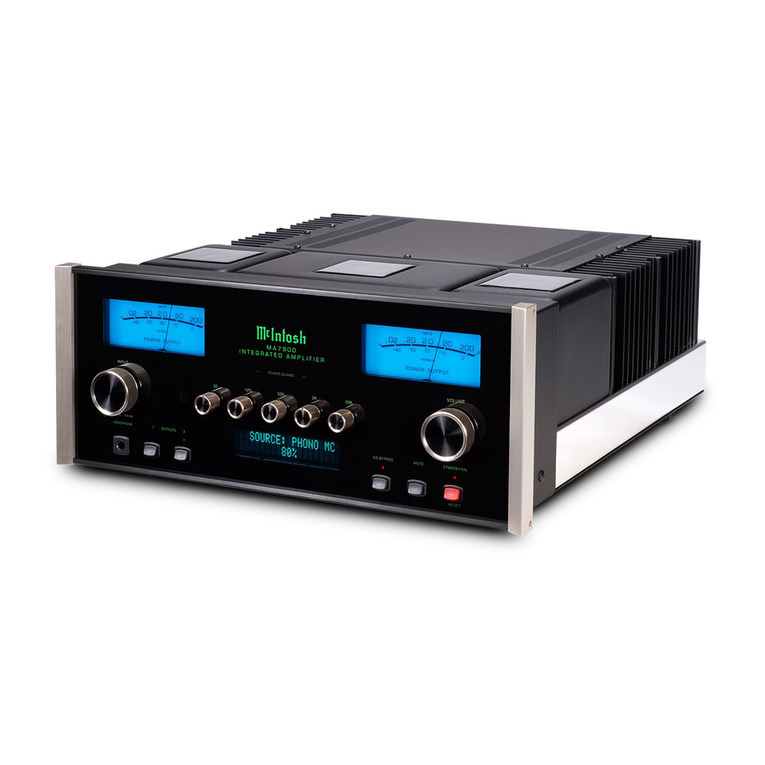
McIntosh
McIntosh MA7900 owner's manual

Peavey
Peavey PA 200 owner's manual
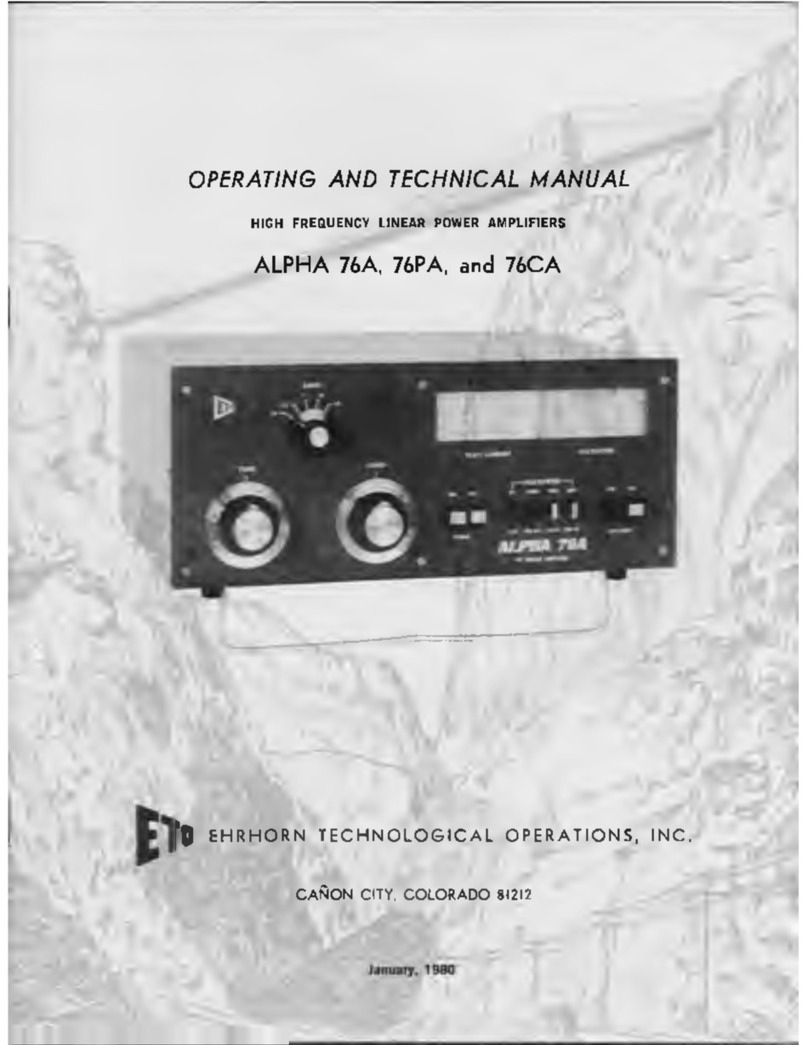
Ehrhorn Technological Operations
Ehrhorn Technological Operations ALPHA 76A Operating and technical manual

Cambridge Audio
Cambridge Audio Azur 540P user manual

Bogen
Bogen Nyquist NQ-A2060 Installation and use
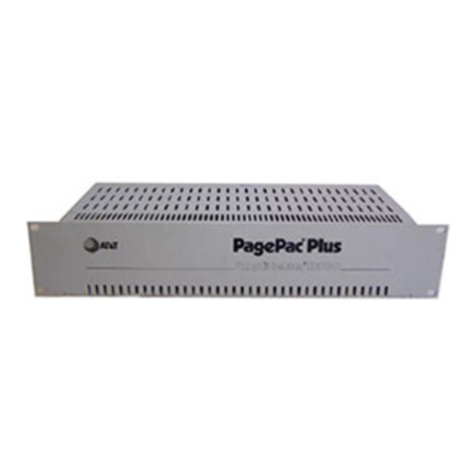
AT&T
AT&T PagePac Plus AmpliCenter Installation and use

Cambridge Audio
Cambridge Audio Azur 840E quick start
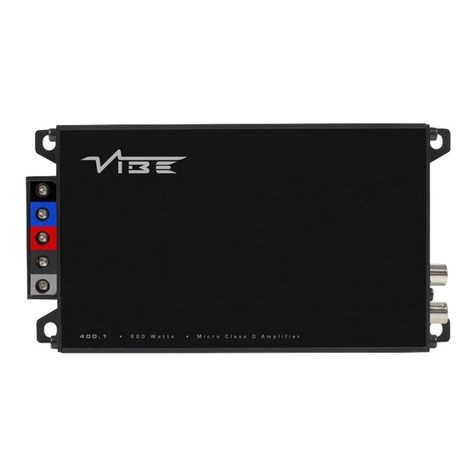
Vibe
Vibe Powerbox Micro POWERBOX 400.1M owner's manual

Ernst Guitar Amps
Ernst Guitar Amps The Singer manual

Carson
Carson SC-1022-20 Installation and operating instructions

EBS
EBS Classic 500 user manual

Extron electronics
Extron electronics HPA 1001-70V Specifications
